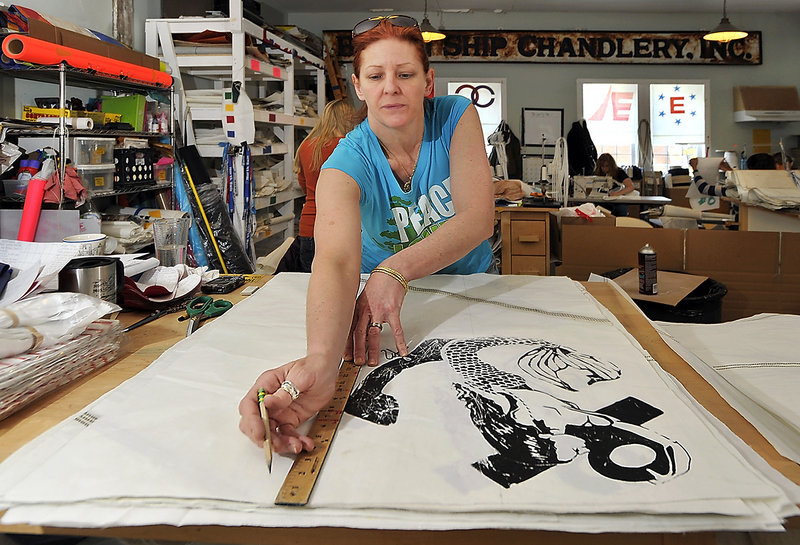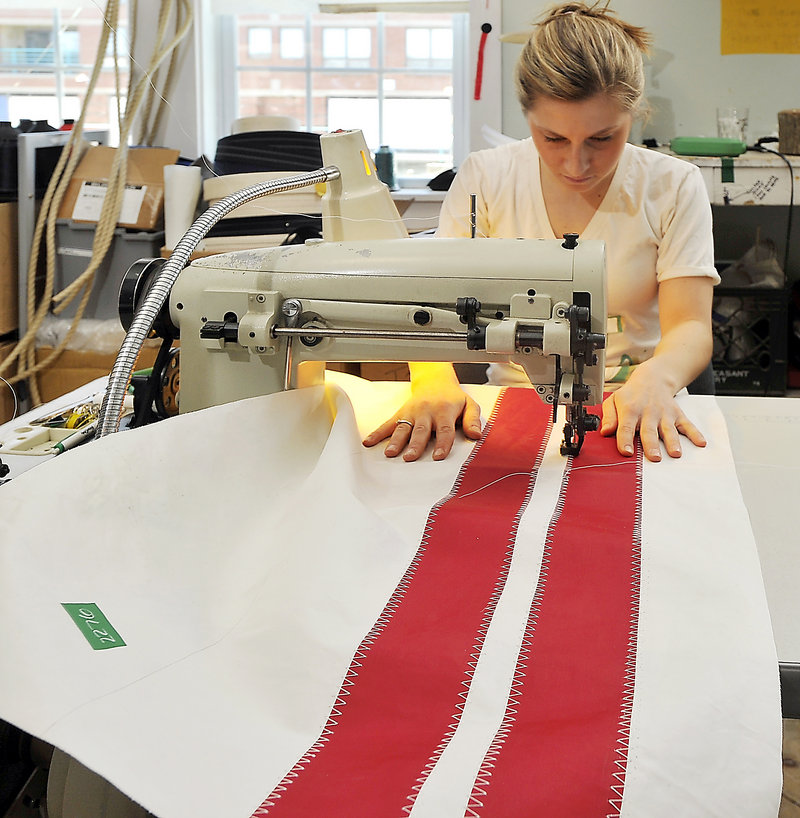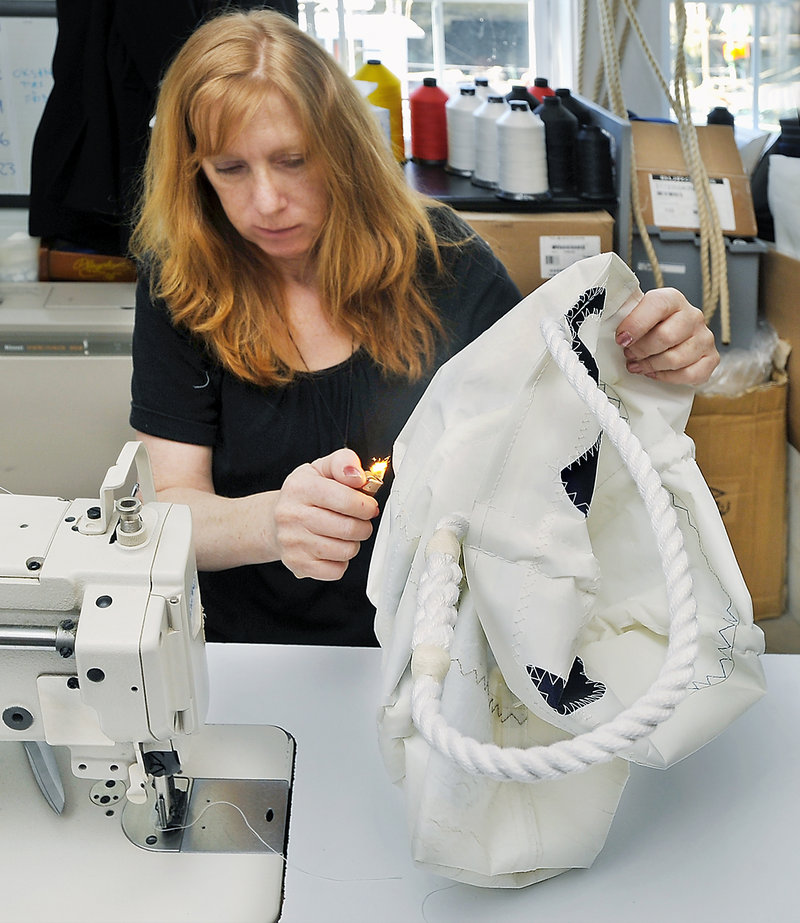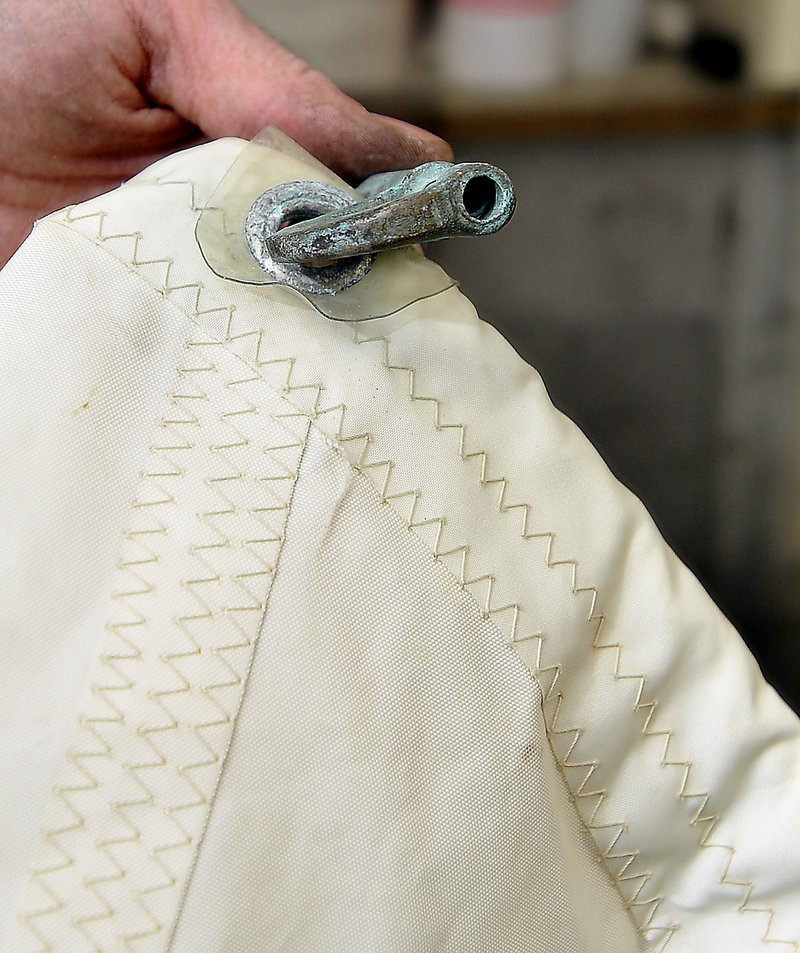PORTLAND – Custom House Wharf may seem an unlikely place for a fashion accessory business.
But for a decade, the wharf has been home to Seabags, a company that makes high-end tote bags from used sailcloth.
Seabags’ owners say the wharf gives their products authenticity and strengthens their brand. It’s part of the reason, they say, that the company has grown from a one-woman operation into an enterprise whose products are sold by small and large retailers nationwide.
“The wharf is our home. At this point, we’re wharf rats,” says Seabags’ co-owner Hannah Kubiak.
You might not see Seabags’ small, unassuming storefront if you’re not searching for it. The place sits roughly halfway down the wharf, just past Harbor Fish Market.
Inside is a small retail space filled with tote bags and accessories. Behind the counter, a handful of employees busily cut sailcloth with heavy-duty shears. Others run sail through sewing machines.
There’s an office in the far corner and a round conference table with four chairs.
The entire room is only 1,600 square feet.
Seabags manufactures roughly 2,000 products here monthly.
Tote bags with rope handles are the company’s signature products. Others include sailcloth wine bags, duffel bags, pillows, coasters, place mats, cosmetic carriers and garment bags.
Nearly all are made on the wharf from used sailcloth, which the company gets from sailors, often in trade for a bag. The sails, made from durable Kevlar, Mylar and carbon fiber, come from boats across the country and overseas.
Seabags’ roots extend to 1969, when Kubiak’s father, Jeff Aumuller, opened Port Canvas Company in Kennebunkport and began selling canvas bags.
Aumuller sold the business in the early 1970s but never lost his enthusiasm. He encouraged Kubiak to sell bags made from sailcloth.
In 1999, Kubiak launched Seabags with partner Dorset Norby. They operated from a 400-square-foot space on the wharf across from Seabags’ current site. (Today, the room is storage, packed floor to ceiling with rolled sails.)
A few years later, Norby stepped down, leaving Kubiak to run Seabags solo.
Managing a small company proved difficult, and Kubiak was more skilled at production than business management.
“I know how to make a bag … (But) I was way over my head in how to run a business,” she said.
Then Kubiak met Isle au Haut native Beth Shissler. At the time, Shissler lived in Massachusetts and managed a multimillion-dollar distribution account for the semiconductor division of Phillips Electronics.
Shissler placed a 10-bag wholesale order with Kubiak. They were for Shissler’s mother, who ran a small gift shop on Isle au Haut.
That summer, the island shop sold out.
The next year, Shissler placed a larger order – 45 bags, a large portion of Kubiak’s entire yearly production then.
Customers gobbled those up, too.
At the time, Shissler wanted a career change; she wanted to work at a small, growing company.
Seabags seemed like a good fit.
Shissler was impressed with Kubiak’s production skills and the quality of her product.
But back then, Seabags, largely a summer business, had just two employees. To grow, Seabags would need branding, marketing and improved distribution.
That’s where Shissler’s business background proved valuable.
In 2005 she proposed joining Kubiak, and the next year they became partners.
Since then, Shissler said Seabags revenue has “grown significantly,” but she declined to disclose specific financial numbers.
The partners attribute that growth to many things, including partnerships with national retailers.
Pottery Barn, for instance, sells Seabags pillow covers. And J.Crew carries bags that Seabags made in partnership with Portland artist Angela Adams.
Seabags also sells products through its website, on the wharf and at a company-owned retail store in Freeport, which is managed by Shissler’s sister, Rhonda Hartley.
Some 500 other small retailers nationwide sell Seabags products.
The company also makes custom products, such as wall coverings and curtains for outdoor showers.
Kubiak and Shissler say recycled sails and their waterfront headquarters distinguish Seabags’ brand. And because scuffed sails make for scuffed bags, no two are alike.
But Seabags does have competition, including companies like Re-Sails, which has stores in Newport, R.I., and Annapolis, Md., Sea Fever Gear in Chatham, Mass., and others.
Shissler said she frequently conducts a comprehensive analysis of Seabags and its competitors to “understand who we are, and what they do.”
Nancy Lawrence, owner of Portland bag maker Portmanteau on Free Street, said she competes with Seabags for local customers.
But Lawrence said her bags are different. She makes them with canvas, not used sailcloth. And she sells many bags for $50 or less. Portmanteau’s higher-end bags top out at about $100.
By comparison, Seabags’ full-size totes range from roughly $100 to $150, though the company sells smaller bags for much less. Some Seabags’ wine bags cost $29.
But Lawrence said Portmanteau and Seabags also have lots in common.
Both companies make bags on site, and both use recycled materials. (Lawrence makes a line of bags from old Portland street banners.)
“The idea of recycling fabric is wonderful,” she said.
Lawrence added that both companies are strong Maine ambassadors.
“We are showing the quality of Maine,” she said. “I would like (customers) to choose anything in Maine over (something made with) cheap labor in China.”
Today, Seabags employs a crew of between 18 and 25 people, including seamstresses, designers and a sail cutter. There’s also a marketing manager, a wholesale manager and a sail acquisition team that hunts for used sails.
Seabags also employs seamstresses on Peaks Island, and some work is done at a factory in Lewiston.
The company makes dozens of varieties of tote bags, some printed with colorful images of anchors, numbers, stripes, whales and fish.
Demand has been so strong that Seabags is hiring additional staff and moving into a 4,000-square-foot space above its current location.
The company’s website was recently retooled with a platform that allows Seabags to sell products in an online auction. Shissler said the auction took 1½ years to develop and is reserved for bags made from unique sails, such as those with vintage insignias.
This spring, Seabags plans to release a line of surfboard shorts, which will be made by another manufacturer under a licensing agreement.
Shissler said Seabags partnered on the project with two former Ocean Pacific staffers who are experts in the surfwear market.
Shissler likened managing the business to a game of Whac-A-Mole, with a variety of challenges popping up as the company grows. For instance, cash flow and the logistics of the move must be monitored, and the company must cope with higher health care and insurance costs.
Shissler said many of those challenges are familiar; the company dealt with them during the last expansion.
“In five years, this has gone full circle,” she said. “We have grown faster than any company has any business growing.”
Shissler added that making money on the wharf with local labor is “tough and expensive.” And she gets why other companies send production offshore.
But Shissler said there’s plenty of skilled local labor, and the waterfront is key to Seabags’ success.
“That’s part of who we are. It keeps us authentic,” she said.
Jonathan Hemmerdinger can be reached at 791-6316 or:
jhemmerdinger@mainetoday.com
Send questions/comments to the editors.






Success. Please wait for the page to reload. If the page does not reload within 5 seconds, please refresh the page.
Enter your email and password to access comments.
Hi, to comment on stories you must . This profile is in addition to your subscription and website login.
Already have a commenting profile? .
Invalid username/password.
Please check your email to confirm and complete your registration.
Only subscribers are eligible to post comments. Please subscribe or login first for digital access. Here’s why.
Use the form below to reset your password. When you've submitted your account email, we will send an email with a reset code.